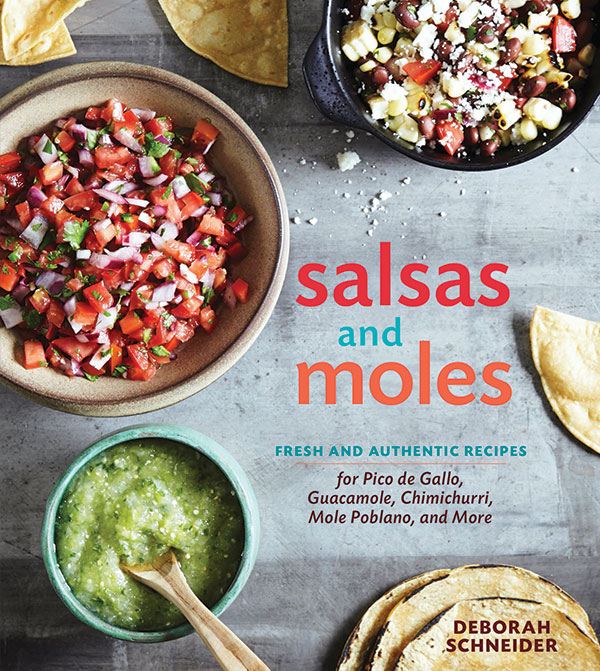Do you know your habanero from your jalapeño? Your poblano from your serrano? We’re talking fresh chiles, of course. In the spirit of Resort 2016’s inspiration in the American Southwest, here’s a primer on peppers, plus a salsa recipe featuring the Hatch chile from New Mexico (a cousin to the mild Anaheim chile), both courtesy of Deborah Schneider’s Salsas and Moles (Ten Speed Press). Just one note of caution from the author: “Always wear disposable gloves when handling any kind of chile.”
Roasted New Mexico Chile Salsa
Ingredients
1/2 white onion, peeled, but with root end intact
3 large Hatch chiles
2 large garlic gloves, unpeeled
4 medium tomatillos, husked, washed and dried or 2 Roma tomatoes
1 1/2 tsp fine kosher salt
Directions
Turn on the fan over the stove. Line a large cast-iron skillet with aluminum foil and set over high heat.
Place the onion, cut-side down, and the chiles, garlic and tomatillos in the pan. Allow the vegetables to blacken in spots before turning. Roast evenly on all sides until the garlic is softened, the tomatillos are beginning to bubble, and the onion is beginning to soften on the outside, 5 to 7 minutes. The chiles should be cooked until they just begin to soften. Remove the vegetables as they are done and set aside to cool.
Peel the garlic and dice the onion. Place in a food processor along with the tomatillos. Peel away as much skin as possible from the chiles and remove the stems and seeds (do not wash!). Tear or cut into small pieces and add to the food processor. Add the salt and pulse a few times; the salsa should be chunky. If you wish, thin the salsa with a little water. Taste and adjust the seasoning as desired. Makes about 1 1/2 cups.
Tips
If you can, choose Hatch chiles with a little orange color on the tips. Out of season, use light green Anaheim chiles instead. Some cooks add a dash of white or apple cider vinegar to this salsa.
Serving Ideas
“I particularly like this salsa on anything fried or with cheese (or both!) and with pork of any kind—carnitas, chicharrón, chorizo or longaniza sausage. It’s delicious with grilled meat and exceptional stirred into a bowl of tender pinto beans. If you have any leftovers, which is unlikely, you can simmer chunks of chicken and onion in the salsa to make a quick chile verde; top it with rich Mexican crema and more onions — there is nothing better.” — Deborah Schneider
Fresh Chiles Guide
Thai Bird Chile
A thin-fleshed chile with many seeds, fruity flavor and searing heat.
Level of heat: 9
Habanero
A very hot chile with a fruity aftertaste. It will make your lips burn and can affect your sense of taste. Handle with care.
Level of heat: 8
Manzana
An unusual chile with coal-black seeds and thick flesh, which needs to be cooked before use. Handle with care.
Level of heat: 7 to 8
Serrano
Narrow and reliably spicy, with a fresh “green” taste and many seeds. Cooking tames its heat. Used for fresh and cooked salsas.
Level of heat: 6
Jalapeño
A rounded chile, wide at the top. Sometimes medium hot, sometimes almost mild. Used in fresh and cooked salsas; also eaten grilled and pickled.
Level of heat: 5
Güero
Thin-fleshed and pale yellow. It can be spicy or mild and must be cooked. Excellent stuffing chile; also eaten grilled.
Level of heat: 4
New Mexico
A large, long, narrow chile resembling an Anaheim but darker in color, with more heat and better flavor. Sometimes called a Hatch chile. Always used cooked.
Level of heat: 3
Poblano
Large, triangular shape, very dark green, and shiny. Must be cooked. Excellent flavor. Used for stuffing or charred and torn up, for rajas, or strips.
Level of heat: 3
Anaheim or California
A large, long, narrow chile with a light green color. Always mild. Use this chile to add flavor without heat.
Level of heat: 1
Red Bell Pepper
Thick-fleshed and sweet. Used raw or cooked to add color and flavor to salsas.
Level of heat: 0
If you want flavor but no heat, substitute an Anaheim chile or green bell pepper for the hot chiles in any recipe. If you like a little heat, remove the seeds and ribs from hot chiles. You may want to scale down to a less hot chile — for example, drop from a serrano to a jalapeño, or a jalapeño to an Anaheim chile. If you like medium heat, keep the seeds and ribs, but add half of the chiles called for in the recipe, then taste. You may decide to add all the chiles. If you like your salsa hot, you can add more chiles or even go up the heat scale by adding a little habanero.
More to explore in Entertaining
-
 Entertaining
5.27.25
The Power of Flowers
Entertaining
5.27.25
The Power of Flowers
-
 Entertaining
5.12.23
A Bakery Inspired by Maman
Entertaining
5.12.23
A Bakery Inspired by Maman
-
 Entertaining
2.10.23
Where to Eat During NYFW
Entertaining
2.10.23
Where to Eat During NYFW
-
 Entertaining
12.14.22
The Ultimate Cheeseboard with Clara Diez
Entertaining
12.14.22
The Ultimate Cheeseboard with Clara Diez
-
 Entertaining
11.14.22
Tory Daily 10: Host with the Most
Entertaining
11.14.22
Tory Daily 10: Host with the Most


